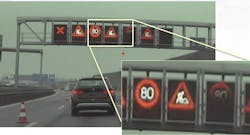Seeing is believing with today’s CMOS image sensor technology
The market for complementary metal oxide semiconductor (CMOS) image sensors continues to grow across a variety of markets, including mobile, automotive, computing, security, medical, and many others. For example, there is an increasing demand for higher-quality photo and video in smartphones that now incorporate two or more cameras—all of which are powered by a CMOS image sensor.
Within the automotive industry, CMOS image sensors are critical to advanced driver assistance systems (ADAS) and autonomous driving. ADAS requires an extensive set of sensors, both outside of the car and inside the cabin to monitor the vehicle’s front side, immediate surroundings and even the drivers and passengers themselves, which significantly drives up the number of image sensors used per car.
Achieving high-dynamic-range (HDR) imaging that delivers vital improvements in image quality and performance—such as improved images in both low-light and bright-light conditions—is a universal requirement across many markets, and a continual challenge that makers of CMOS image sensors face.
Enhancing HDR with LOFIC technology
Some applications require HDR with a single exposure—here is how it can be achieved.
In dual conversion gain (DCG) pixels, a photodiode’s photoelectrons are read out twice with different gains: high-conversion gain (HCG) and low-conversion gain (LCG). The higher gain enables lower readout noise, while the lower gain enables larger effective full well capacity. And the combination of HCG and LCG data realize single exposure HDR.
A sensor that uses lateral overflow integration capacitor (LOFIC) technology stores more signal electrons by collecting the overflow charge from the photodiode in a large capacitor within each pixel. And the combination of photodiode channel and the LOFIC channel data enables both higher dynamic range and higher signal-to-noise ratio (SNR) at the same time, with single exposure. By harnessing LOFIC’s unique capabilities, HDR imaging can be effectively enhanced, which allows for superior image quality across a wide range of lighting conditions.
TheiaCel addresses these challenges. It is a combination of LOFIC and other OMNIVISION proprietary single-exposure HDR solutions, and is key to achieving low noise readout, high-sensitivity operation, large full-well capacity, and a linear response using a single exposure.
Mitigating LED flicker in automotive cameras
In the automotive market, flicker from LED traffic lights or traffic signs poses a serious challenge for HDR solutions (see Fig. 1), which prevents driver-assistance and autonomous driving systems from being able to correctly detect lighted traffic signs.
Multiple exposure HDR imaging techniques often struggle to provide consistent performance in capturing LED light sources. Pulse-width modulation (PWM) in LED light sources creates issues in short exposure time data. If that short exposure timing falls in between the LED pulses, the sensor doesn’t detect the LED light. Video stream flicker is created by frames missing the “on” pulse when the sensor tries to capture bright LED light with short exposure time channel. The dilemma is that, although the longer exposure time channel does not miss the timing, it causes excess pixel saturation by the LED.
The goal is not only to achieve HDR performance, but also to prevent the LED light image data from flickering. Mitigating this challenge requires an approach that can be easily integrated into a CMOS image sensor. Some solutions that have achieved good LED flicker mitigation (LFM) capabilities have resulted in reduced image quality, especially for low-light SNR, high-temperature performance, etc.
It is also important to prevent a drop in SNR at the signal transition point or knee point of the SNR curve. TheiaCel technology realizes that. Combining DCG with LOFIC or combining DCG and split-diode with LOFIC significantly improves LFM range for single-exposure HDR. A split-diode LOFIC sensor achieves the ultimate LFM range, while a single-photodiode LOFIC sensor enables a good balance between low-light SNR and dynamic range in a small-pixel product.
Single-photodiode LOFIC architecture was applied to 2.1 µm pixel-generation automotive sensors to enhance the HDR image and mitigate LED flicker in virtually any lighting condition.
Improve smartphone camera performance in all lighting conditions
The latest application of TheiaCel technology targets rear-facing main cameras in flagship smartphones, delivering the highest available HDR to enable the highest-quality photos and videos in both low-light and bright-light conditions.
The requirement for single exposure HDR is growing in importance for the mobile market because multiple exposure HDR solutions suffer from LED flicker, similar to that of automotive sensors. In addition, CMOS image sensors in the flagship mobile segment are getting higher and higher in sensitivity. Sometimes the sensitivity is too high to keep up exposure time long enough for compensating the flicker in a room illuminated by bright fluorescent light.
This creates a significant opportunity for OMNIVISION: the combination of its proven 50MP image sensor technology with TheiaCel LOFIC + dual analog gain (DAG) technology addresses these challenges, enabling users to capture better, clearer, more beautiful images and videos, with better detail in bright light and less noise in low light, regardless of the light source (see Fig. 2).
HDR imaging is entering an era in which existing solutions cannot address some key requirements. Recent advances enable LOFIC technology to solve challenges that existing solutions can’t.
This creates a significant opportunity for a new approach: the combination of proven 50 Mpixel image sensor technology with TheiaCel LOFIC and DCG technology addresses these challenges, which enables users to capture better, clearer, more beautiful images and videos, with better detail in bright light and less noise in low light (see Fig. 2).
HDR imaging is entering an era in which existing solutions cannot address some key requirements. Recent advances enable LOFIC technology to solve challenges that existing solutions can’t.
About the Author
Eiichi Funatsu
Eiichi Funatsu is vice president of technology for OMNIVISION (Santa Clara, CA).

